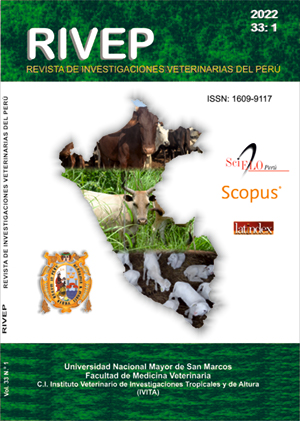Sensitivity and specificity of the enzyme-linked immunoelectrotransfer blot test (EITB) for the diagnosis of hydatidosis in sheep
DOI:
https://doi.org/10.15381/rivep.v33i1.22156Keywords:
ovine hydatidosis, EITB test, active cyst, sensitivity, specificityAbstract
The aim of the study was to evaluate the enzyme-linked immunoelectrotransfer blot test (EITB) in the serological diagnosis of ovine hydatidosis. In total, 80 Corriedale sheep from SAIS Pachacútec, Junín, Peru, were used and the results compared with the necropsy (gold standard). The simultaneous presence of three antigenic bands (8, 16 and 21 kDa) in the EITB was considered a positive result, while the necropsy result was positive if there was at least one cyst in the liver or lungs. The EITB showed a low sensitivity (31.2%) and a high specificity (100%). Likewise, positive (PPV) and negative (NPV) predictive values of 100 and 5.4%, respectively, but without significant association (p=0.55) between the test result and the presence of cysts. To determine the usefulness of EITB in the detection of active cysts, the presence of at least one antigenic band was considered as positive and as an active cyst (active infection) the structure that, due to its macroscopic conditions, could contain cells capable of proliferating under adequate conditions. The results showed a high sensitivity (93.6%) of the test to identify active cystic lesions with PPV of 60.3% and NPV of 57.1%, although the results were not statistically significant (p=0.439). The findings show that the EITB test reaction is not necessarily more sensitive when active cysts are present.
Downloads
Downloads
Published
Issue
Section
License
Copyright (c) 2022 Karina Bardales-Ortiz, Raúl Enríquez L., Cesar Sedano H., Saul J. Santivañez S., Armando González Z.

This work is licensed under a Creative Commons Attribution 4.0 International License.
AUTHORS RETAIN THEIR RIGHTS:
a. Authors retain their trade mark rights and patent, and also on any process or procedure described in the article.
b. Authors retain their right to share, copy, distribute, perform and publicly communicate their article (eg, to place their article in an institutional repository or publish it in a book), with an acknowledgment of its initial publication in the Revista de Investigaciones Veterinarias del Perú (RIVEP).
c. Authors retain theirs right to make a subsequent publication of their work, to use the article or any part thereof (eg a compilation of his papers, lecture notes, thesis, or a book), always indicating the source of publication (the originator of the work, journal, volume, number and date).










